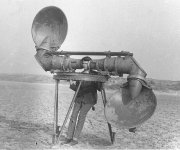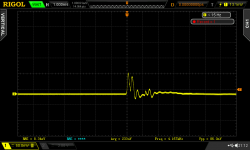Scott...
Or it's just that hat you are wearing in the photo... It seems to be covering your ears.
😀
I thought it was his hair! Felt too bad to ask 🙄
Or it's just that hat you are wearing in the photo... It seems to be covering your ears.
😀
That's a fright wig. At my age the only hair in the way is the stuff that grows out of the ears.
Unequivocally no...
The stand is not made of an exotic wood. How could it possibly sound good?
😀
The stand is not made of an exotic wood. How could it possibly sound good?
😀
Good read, actually. Interesting with the classical conditioning of the wife... Thanks for posting.
~Tom
Would these do???
Look up 'cone of confusion' as related to hearing. Some owls have it built-in.
I did notice before reading SY's excellent article how often 'the wife' gets cited in such things.......at least this helps make some sense of the whole thing IMO.Good read, actually. Interesting with the classical conditioning of the wife... Thanks for posting.
Ime synthetic carpets can be quite strongly effecting, adding a 'loaded down' effect and a harshness that does not belong.I don't have carpet is that why I heard no difference?
Wood and parquetry can sound quite ok, bare concrete causes a 'dullness'.
Dan.
bare concrete causes a 'dullness'.
Dan.
Attachments
I've linked to this elsewhere, but it's worth repeating. For those who believe there is just no way their senses could be fooling them, I suggest checking out Michael Shermer's TED talk on Why People Believe Weird Things (13-minute video). For those who would like to skip directly to the auditory illusion, fast forward to 8:00 into the video.
~Tom
~Tom
Thanks tomchr, that's hugely entertaining. It also illustrates how important an entry point or cue as to what to expect can be as part of phantom perception. It baffled me for ages how different people could apparently perceive similar effects in audio which IMO are very probably phantom. Then I realised there is near always a cue or clue included as to what to expect, and I think this video illustrates nicely how such shared expectation seems to influence perception. Fascinating, I find.I've linked to this elsewhere, but it's worth repeating. For those who believe there is just no way their senses could be fooling them, I suggest checking out Michael Shermer's TED talk on Why People Believe Weird Things (13-minute video). For those who would like to skip directly to the auditory illusion, fast forward to 8:00 into the video.
~Tom
I think that it is reasonably widely accepted nowadays that different turntables sound different. Back in the 1960s anyone putting forward that view would have been laughed at, and had sneering jokes at their expense. If the speed and wow and flutter figures were the same, then they sounded the same.
With turn tables, one can at least make the argument that motor vibration, mechanical resonances within the turn table, etc. could color the sound. That's a physics-based argument.
The argument that somehow synthetic materials affect the flow of electrons in a wire laying atop the synthetic material is absurd and based in pseudo-science. It's rather well known how charges behave. See the entire field of quantum mechanics and device physics.
If you want to laugh at me 60 years from now, go ahead... 🙂
~Tom
The argument that somehow synthetic materials affect the flow of electrons in a wire laying atop the synthetic material is absurd and based in pseudo-science. It's rather well known how charges behave. See the entire field of quantum mechanics and device physics.
If you want to laugh at me 60 years from now, go ahead... 🙂
~Tom
You can get microphony in cables, I've got some coaxes which generate some pretty good signals when bent. However the effect generates charge, which needs impedance to turn into voltage. The effect is spectacular on a scope (imput impedance 1MOhm) or a low noise preamp, however, when considering the output impedance of a power amp and loudpseakers in parallel, you can expect the resulting voltage to be infinitesimal.
They make "low noise cables" for stuff like EEG or vibration sensors, those got a special anti-triboelectric layer inside. Balanced microphone cables are filled with cotton because if they weren't you'd hear a THUMP everytime someone walks on them. All those have a thing in common : high source impedance.
Here is a scope shot... it's a 50 ohm coax that's been hit with a pencil. It generates some 85mVpp into 1Mohm. This tells that this particular coax isn't to be trusted if measuring stuff from a high impedance source. If the source impedance was 1 ohm, well, the effect would be 1 million times less... on a typical audio amp output impedance it would be in the nanovolts... would probably make less noise than a flea fart...
A simple test would be to grab your speaker cable and wiggle it. Does it make noise in the speakers ?... Probably not... if it does then you got a bad contact somewhere and a bit of DC on the amp output...
They make "low noise cables" for stuff like EEG or vibration sensors, those got a special anti-triboelectric layer inside. Balanced microphone cables are filled with cotton because if they weren't you'd hear a THUMP everytime someone walks on them. All those have a thing in common : high source impedance.
Here is a scope shot... it's a 50 ohm coax that's been hit with a pencil. It generates some 85mVpp into 1Mohm. This tells that this particular coax isn't to be trusted if measuring stuff from a high impedance source. If the source impedance was 1 ohm, well, the effect would be 1 million times less... on a typical audio amp output impedance it would be in the nanovolts... would probably make less noise than a flea fart...
A simple test would be to grab your speaker cable and wiggle it. Does it make noise in the speakers ?... Probably not... if it does then you got a bad contact somewhere and a bit of DC on the amp output...
Attachments
Last edited:
I think that it is reasonably widely accepted nowadays that different turntables sound different. Back in the 1960s anyone putting forward that view would have been laughed at, and had sneering jokes at their expense.
People were well aware of this in the 1960s.
You can get microphony in cables, I've got some coaxes which generate some pretty good signals when bent. However the effect generates charge, which needs impedance to turn into voltage. The effect is spectacular on a scope (imput impedance 1MOhm) or a low noise preamp, however, when considering the output impedance of a power amp and loudpseakers in parallel, you can expect the resulting voltage to be infinitesimal.
They make "low noise cables" for stuff like EEG or vibration sensors, those got a special anti-triboelectric layer inside. Balanced microphone cables are filled with cotton because if they weren't you'd hear a THUMP everytime someone walks on them. All those have a thing in common : high source impedance.
Here is a scope shot... it's a 50 ohm coax that's been hit with a pencil. It generates some 85mVpp into 1Mohm. This tells that this particular coax isn't to be trusted if measuring stuff from a high impedance source. If the source impedance was 1 ohm, well, the effect would be 1 million times less... on a typical audio amp output impedance it would be in the nanovolts... would probably make less noise than a flea fart...
A simple test would be to grab your speaker cable and wiggle it. Does it make noise in the speakers ?... Probably not... if it does then you got a bad contact somewhere and a bit of DC on the amp output...
Coaxial cable is not figure 8 speaker cable which is typically used for speaker connection.
Coaxial cable connected to a high input impedance of a pre-amplifier acts as a capacitor in parallel with that input, and as capacitors maintain even a minute value of charge in their dielectric any change in capacitance due physical distortion will no doubt produce a voltage change at the input of the pre-amplifier and thus will be amplified.
But of course that is not what we are talking about.
C.M
Last edited:
Indeed. As peufeu points out, speaker cables are always shunted by low impedance which settles the matter anyway, no matter whether fig 8 or co-ax. Besides, signal levels in speaker cables are perhaps 80dB (x10,000) larger than microphone level. Speaker cables aren't microphonic in use, in my book.But of course that is not what we are talking about.
Last edited:
Cable lifters and stands
My memory is of reviews discussing measurements and build quality, not subjective valuations of their sound. But then I only read Hi Fi News in those days, which was pretty staid.
Perhaps I should just have said that although I think lifting cables is nonsense, ridiculing it from the position of not trying it, would say more about me than the viability of the idea.
People were well aware of this in the 1960s.
My memory is of reviews discussing measurements and build quality, not subjective valuations of their sound. But then I only read Hi Fi News in those days, which was pretty staid.
Perhaps I should just have said that although I think lifting cables is nonsense, ridiculing it from the position of not trying it, would say more about me than the viability of the idea.
- Status
- Not open for further replies.
- Home
- Member Areas
- The Lounge
- Speaker Cable lifters or stands?


